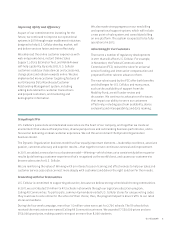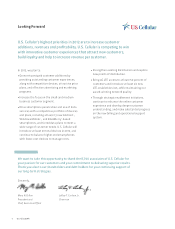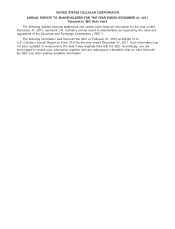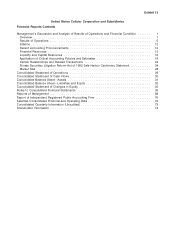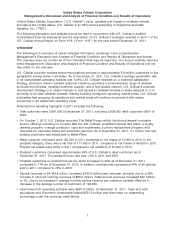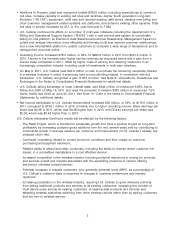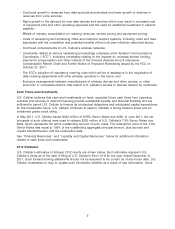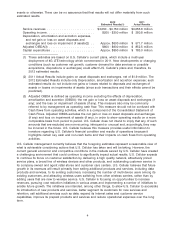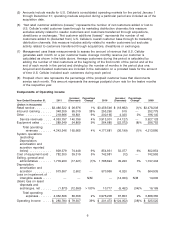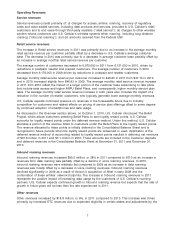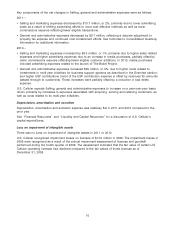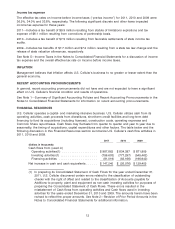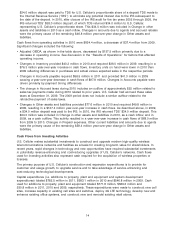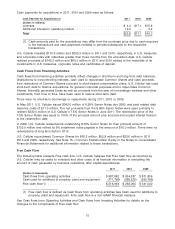US Cellular 2011 Annual Report Download - page 15
Download and view the complete annual report
Please find page 15 of the 2011 US Cellular annual report below. You can navigate through the pages in the report by either clicking on the pages listed below, or by using the keyword search tool below to find specific information within the annual report.Operating Revenues
Service revenues
Service revenues consist primarily of: (i) charges for access, airtime, roaming, recovery of regulatory
costs and value-added services, including data products and services, provided to U.S. Cellular’s retail
customers and to end users through third-party resellers (‘‘retail service’’); (ii) charges to other wireless
carriers whose customers use U.S. Cellular’s wireless systems when roaming, including long-distance
roaming (‘‘inbound roaming’’); and (iii) amounts received from the Federal USF.
Retail service revenues
The increase in Retail service revenues in 2011 was primarily due to an increase in the average monthly
retail service revenue per customer partially offset by a decrease in U.S. Cellular’s average customer
base. The decrease in 2010 was primarily due to a decrease in average customer base partially offset by
an increase in average monthly retail service revenue per customer.
The average number of customers decreased to 5,975,000 in 2011 from 6,121,000 in 2010, driven by
reductions in postpaid, reseller and prepaid customers. The average number of customers in 2010
decreased from 6,176,000 in 2009 driven by reductions in postpaid and reseller customers.
Average monthly retail service revenue per customer increased to $48.63 in 2011 from $47.10 in 2010,
and in 2010 increased slightly from $46.93 in 2009. The average monthly retail service revenue increase
in 2011 from 2010 reflect the impact of a larger portion of the customer base subscribing to rate plans
that include data access and higher ARPU Belief Plans, and consequently, higher monthly service plan
rates. The average monthly retail service revenue increase in both years also includes the impact of a
reduction in the number of reseller customers, who typically generate lower average monthly revenues.
U.S. Cellular expects continued pressure on revenues in the foreseeable future due to industry
competition for customers and related effects on pricing of service plan offerings offset to some degree
by continued adoption of smartphones and data usage.
As discussed in the Overview section above, on October 1, 2010, U.S. Cellular introduced The Belief
Project, which allows customers selecting Belief Plans to earn loyalty reward points. U.S. Cellular
accounts for loyalty reward points under the deferred revenue method. Under this method, U.S. Cellular
allocates a portion of the revenue billed to customers under the Belief Plans to the loyalty reward points.
The revenue allocated to these points is initially deferred in the Consolidated Balance Sheet and is
recognized in future periods when the loyalty reward points are redeemed or used. Application of the
deferred revenue method of accounting related to loyalty reward points resulted in deferring net revenues
of $31.8 million in 2011 and $7.1 million in 2010. These amounts are included in the Customer deposits
and deferred revenues in the Consolidated Balance Sheet at December 31, 2011 and December 31,
2010.
Inbound roaming revenues
Inbound roaming revenues increased $95.0 million, or 38% in 2011 compared to 2010 as an increase in
revenues from data roaming was partially offset by a decline in voice roaming revenues. In 2010,
inbound roaming revenues were relatively flat compared to 2009 as an increase in data roaming
revenues was mostly offset by a decrease in voice roaming revenues. Inbound roaming revenues
declined significantly in 2009 as a result of Verizon’s acquisition of Alltel in early 2009 and the
combination of these entities’ network footprints. The increase in Inbound roaming revenues in 2011
represents the positive impact of increasing data usage by the customers of U.S. Cellular’s roaming
partners. U.S. Cellular expects continued growth in Inbound roaming revenue but expects that the rate of
growth in future years will be less than the rate experienced in 2011.
Other revenues
Other revenues increased by $18.8 million, or 9%, in 2011 compared to 2010. This increase was driven
primarily by increased ETC revenues due to expanded eligibility in certain states and adjustments by the
7


